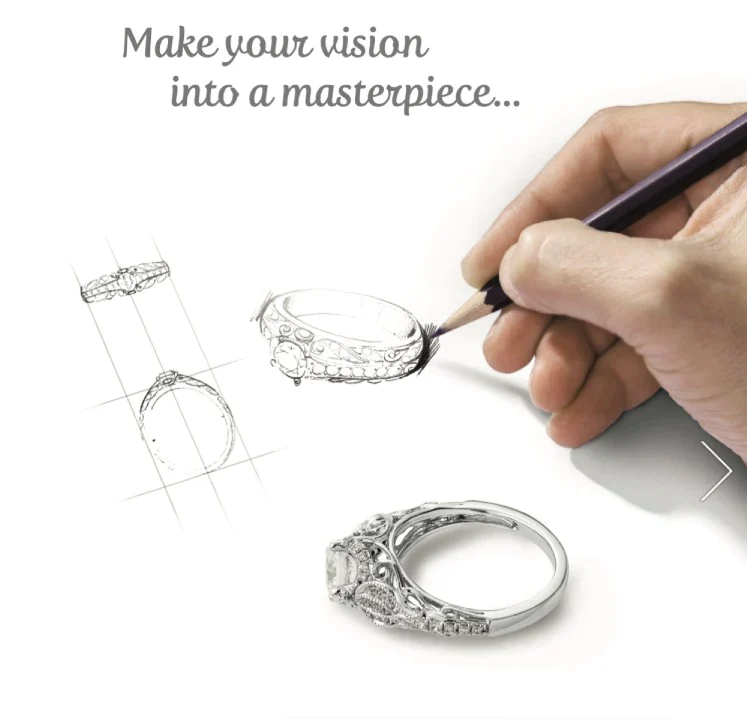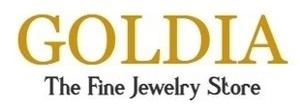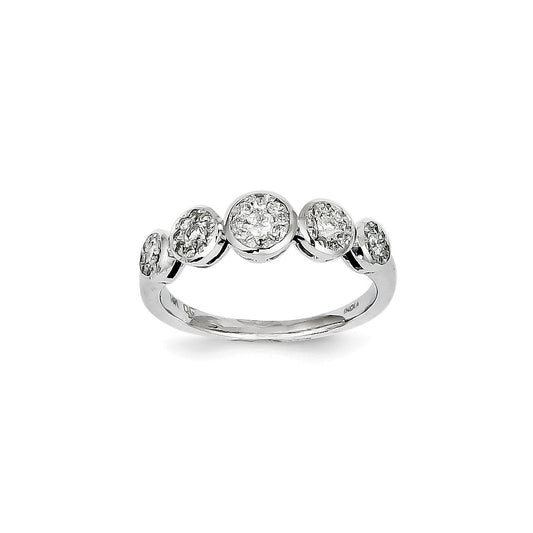Collection: Vintage Diamond Anniversary Bands
Vintage Diamond Anniversary Bands
Almost everyone is in love with diamonds. Diamonds are gorgeous gemstones that are known for their various cuts, brilliance, fire, uses, and visual appeal.
Getting a diamond engraved band for that anniversary would be a great idea. How about getting a vintage diamond?
What is a vintage diamond?
A vintage diamond dates far back into the 1920s through the 1960s. These diamonds were handmade as there was no edge-cutting technology and machines to aid their precision and symmetry. Their proportions were judged by the jeweler's eye.
Characteristics of a vintage diamond
• They are diamonds that were mined, cut, and polished at least 60 years ago.
• They are characterized by uneven facets.
• Most vintage diamond cuts have high crowns(the upper part of the diamond; above the girdle).
• Vintage diamonds have deep pavilions(the part of the diamond below the girdle).
• They have frosted or bruted girdles.
• They usually have large culets.
• Vintage diamonds cut to be round are usually off-round, due to the absence of machine accuracy.
• They appear bulky in comparison to modern brilliant diamonds.
• They exhibit unique sparkle in dim lighting.
• They are handmade.
Antique Diamonds Vs. Vintage Diamonds
If you are interested in vintage gems, particularly diamonds, you may have heard about antique diamonds. Most people confuse antique and vintage diamonds as the same thing which is incorrect.
Antique diamonds are diamonds from at least 100 years ago. Antique and vintage diamonds were cut according to the eras in which they were discovered.
These diamonds were not made to maximize brilliance as is the case with the modern brilliant diamonds. They were made to limit wastage, maximizing carat weight.
Antique diamonds go far back into the 1300s. Regardless, antique and vintage diamonds are regarded as old cut stones.
Vintage And Antique Diamond Cuts
If you are looking for vintage diamond jewelry; perhaps, a ring or a necklace; whether it’s for your engagement or anniversary or you just want one, there are a variety of vintage diamond cuts to select from.
We’ll be looking at the various diamond cuts ranging from the 1300s to the mid-20th century. It’s important to note that you may not get some of these cuts the way they were made during their era. If you do, by any chance, it will be extremely expensive
• Point Cut Diamonds: These are the earliest diamond cuts on the record. As with most vintage diamonds, they were made to maximize carat weight. These diamonds were not cut at all, at least according to modern cutting standards. They were polished to a point(hence the name). This helped the diamond maintain its natural octahedral shape.
It is also called the eight-cut diamond. This is due to it having eight facets on its crown and eight facets on its pavilion.
• Table Cut Diamonds: These vintage diamonds are so named because the top of their crown is flat as a tabletop. The side facets are shaped like a bevel. The table-cut diamonds date back to the 16th century but were mostly utilized from the 17th century through the early 18th century.
• Rose Cut Diamonds: After the table cut came the rose-cut diamonds. Dated far back into the 1600s through to the late 18 th and 19th centuries and even up to the early 20th century.
These diamonds are characterized by their dome shape and nonexistent pavilion. That’s right! These gorgeous diamonds have no pavilion. Rather they have a smooth flat surface below their girdle.
Rose-cut diamonds have the name because their facets are arranged in a manner that resembles a rose in bloom. This arrangement also makes the rose-cut diamond appear bigger than other vintage diamonds of equal carat weight.
Rose-cut diamonds are always out of round, that is, they are never perfectly round. Again, we owe this to it being handmade. If you find a perfectly round rose-cut diamond, it is likely a modern, machine-cut diamond made to look like a vintage diamond.
Although a rose-cut diamond will barely exhibit brilliance, it is a gorgeous choice for an anniversary band. It’ll look like you’re wearing a rose on your finger, how exciting is that?
• Old Mine Cut Diamonds: Also called miner cut, they were found initially in the 18th century. These diamonds follow the rose-cut diamonds and began the era of brilliant diamonds.
Old mine diamonds are characterized by a high crown, small table, large culet, and long pavilion. It has 58 facets which greatly affect the dispersion of lights, making it one of the first diamonds that exuded brilliance.
It is usually a square or rectangular-shaped diamond with round edges making it similar to a modern cushion diamond.
Centuries ago, diamond mines were found only in India and Brazil. Then in the late 18th -century diamond mines were discovered in South Africa. This resulted in massive diamond exploration on the continent. Since old mine cuts were originally gotten from the Brazilian and Indian mines, it earned its name. At the time, these mines were considered the “old mines.”
• Old European Cut Diamonds: These diamonds were cut according to a style developed in Europe. They were popular from 1890 to 1930. Although Old European cut diamonds are still very much in demand today.
The diamond has a round appearance when viewed from above(the table). During its time, a wheel that aided the cutting of jewelry was discovered. This made it have a distinct round shape. Even still, the circles were uneven as the wheel barely holds against today’s machines.
It has a high crown, a small table, and an open culet. It is also a diamond with 58 facets.
When compared to the old mine cut, the old European cut is found to have a shorter crown, deeper pavilion, smaller table, and of course is round as opposed to the old mine cut's square shape.
It is said to be the most advanced vintage diamond as the similarities to the modern brilliant diamond are outstanding. So, it is a perfect vintage diamond anniversary band if you want something similar to the modern brilliant cut.
• Asscher Cut Diamond: If you’re a fan of diamonds with octagonal shapes then this cut will most likely impress you. It was perfected in the early 19th century by the Asscher brothers.
It features a high crown, a deep pavilion, and layered(step-like) facets. There are two types of vintage Asscher cuts. There is the standard Asscher cut which has 58 facets and the Royal Asscher cut with 74 facets.
It is similar to the emerald-cut diamonds, only that this vintage diamond is cut in a square shape rather than the rectangular shape of the emerald-cut diamonds.
• Emerald-Cut Diamonds: These vintage diamonds are so-called because the cutting style was initially used on emeralds. These diamonds have layered facets. They were standardized in the 1940s. A vintage emerald cut will have a larger crown and a smaller table.
Most of these vintage cuts were made to sparkle in the candlelight. Hence, they have a peculiar and spectacular sparkle when placed in dim lighting. This gives vintage diamonds a romantic and poetic feel, making them a perfect choice for your anniversary band.
Eras And Movements That Influenced Vintage Diamond Styles
The diamond cutting techniques mentioned above were developed before or at the very beginning of the industrial revolution.
The antique and vintage diamond date from eras that marked many styles in jewelry making. Here are some of the eras and movements to keep in mind to aid your search for the vintage diamond that works for you.
• Georgian Era(1714-1830): Diamonds from this era are rare. This is not due to the era being centuries ago. Rather, it’s because diamond mines were rare in this era. Resulting in curiosity and a great passion for the gem.
The old European diamond was found initially in this era. Though, rose-cut diamonds were a favorite as well.
• Victorian Era(1837-1901): The old mine cut was particularly popular in these times. Victorians loved anything that had meaning, it wasn’t any different for jewelry. Snake shapes and yellow gold rings reigned as well.
It was believed at the time that snakes signified love, so these reptiles appeared in many jewelry designs including Queen Victoria's engagement ring, given to her by Prince Albert.
It’s no wonder that vintage diamonds from this era serve as beautiful anniversary bands.
• Art Nouveau And Edwardian Eras(1890-1910): The art nouveau movement overlapped with the short reign of King Edward.
The Edwardian era followed the same trends as the past era. It was a continuation of the tendencies and cutting styles of jewelry used in the Victorian era.
While the art nouveau movement had a big impact on jewelry making it concerned itself with nature above all things. Diamonds were not a favored choice among the followers of this moment, due to their origin.
• Art Deco Era(1920-1930): Just like the movement, art deco jewelry had major changes which were their geometric shapes, straight lines and the unusual combinations of gems in this era.
Diamonds cut in this era focused on sharp edges, contrasting colors, and pairing with unusual gems.
Vintage diamonds from this era were usually combined with contrasting stones in jewelry with bright colors. Platinum was a major metal used at the time.
Vintage diamonds from the art deco era are one of the highest in demand. A vintage anniversary band from this time won’t be a bad choice.
• Retro Era(1940-1950): This era came post-world wars. The jewelry made in this time was like a blend of the past with the present.
The designs were striking, from the geometric and modern to the romantic and poetic appeal of the Victorian era styles.
These are the eras that influenced the vintage designs of diamonds that have long passed away. However, the demand for these diamonds in the modern day is on the increase. People want variety, uniqueness, something different. Vintage diamonds give that and so much more. So, how do you choose your vintage diamond?
Selecting A Vintage Diamond Anniversary Band
You’ve learned all about the various vintage diamond anniversary bands cut and the eras that influenced them. Now, it’s time to pick the diamond that works for you. Although there are some vintage diamonds without certification, there’s a great variety that follows the grading of 4 c’s.
• Clarity: In nature hardly anything is created “perfect”. Diamonds are gems that are formed under intense heat and pressure deep below the earth's crust. Hence, there are likely to be blemishes on the gem.
Clarity refers to the level of flawlessness of a diamond. It is appraised with a loupe on ×10 magnification. A vintage diamond is likely to have more than a few inclusions, and the flawless ones, if any, may be very expensive.
The clarity scale ranges from “flawless” which is the top grade to “included” being at the low end of the scale.
• Cut: We have talked extensively about the various vintage diamond cuts. Cut refers to two things when grading diamonds; the overall shape of the diamond and how well the diamond is physically cut.
A well-cut diamond will disperse the lights that enter it to give sparkle. However, most vintage diamonds were not designed for sparkle. You can consider the diamond's cut when selecting one but be sure to know that these diamonds were made to maximize carat weight.
• Carat: This is the easiest of the 4 c’s to understand. It is a term used to describe the unit weight of diamonds. One carat=200 milligram.
A diamond is weighed on a very sensitive scale to obtain its accurate weight. A diamond's value directly relates to how much it weighs. A larger diamond will be more valuable and rare than a smaller diamond.
• Color: Vintage diamonds were found in mines characterized by warm colors. Your vintage diamond anniversary band will most likely have a hint of yellow, making it all the more unique.
The colors range from “D” being colorless to “Z” being quite yellow or brown. Colorless diamonds are extremely rare and expensive. When a diamond's color grade passes “Z”, it is referred to as a “fancy” diamond. Believe it or not, this makes it more desirable, and expensive.
A vintage diamond will most likely have its color range between K-L-M. However, the proportions of vintage diamonds worked to mask the color grade assigned to them. Hence, they appear colorless when viewed from the top.
It’ll be reasonable to follow these 4 c’s when choosing your diamonds but a lot of vintage diamonds do not follow these grading scales. This is because they were handmade, and each cut is unique to the individual's eye.
Take a look at the vintage diamonds, pick the one that suits your taste. You’ll gain more satisfaction this way than by following the above grading scale.
Because these diamonds are old cuts, they are likely to have blemishes. Purchasing your vintage diamond anniversary band from just any store won’t do you good. It’ll be wiser to inquire about the diamond from a trusted jewelry brand, click here.
Why Choose A Vintage Diamond Anniversary Bands For Your Ring
Using a vintage diamond anniversary bands in your ring is a matter of preference. However, there are a few upsides to using these old cut diamonds.
• One-Of-A-Kind: This is an obvious advantage to choosing a vintage diamond. Every diamond is unique. They were handmade, after all, accuracy was rather far-fetched. If you want a ring that is peculiar to you, then vintage diamonds are the way to go.
Their uneven proportions and symmetry which are nerve-wracking to some are the exciting aspects of a vintage diamond to others.
• Warmer Colors: Many couples today will opt for a colorless gem in their anniversary bands. But if you choose to use a vintage diamond, then you’ll most likely be getting a gem with hints of yellow or brown.
The exciting aspect of this is that when you view the diamond from the top, it’ll appear to be colorless but a closer look will reveal the tiny hints of warm colors. It doesn’t get more special than that!
• Environmentally Friendly: Vintage diamonds are considered sustainable and environmentally friendly as the mining process to obtain these diamonds have already been carried out.
• Pricing: A vintage diamond will, in most cases, cost 20% less than a modern diamond of equal carat weight. Just like its sustainability, this is because a vintage diamond does not require new mining and all the associated costs.
Although, a rare vintage diamond will most likely cost more than a modern brilliant diamond.
If your anniversary is coming up and you’re looking for the perfect ring to gift your partner, I'm sure you can agree with us that a vintage diamond anniversary ring is the way to go.
-
14k White Gold Diamond Band Ring
Regular price $754.00 USDRegular priceUnit price / per$1,884.00 USDSale price $754.00 USDSale

Are the Products Above not Really What You are Searching for?
Let us help make your dream jewelry a reality! Use our easy three part Get-A-Quote form to begin the magic of creating your own, custom designed jewelry. Fill in your Contact Information, Jewelry Information, Upload Images, and add any Notes - click Submit, and one of our design team reps will be in touch within 12-24 hours.





